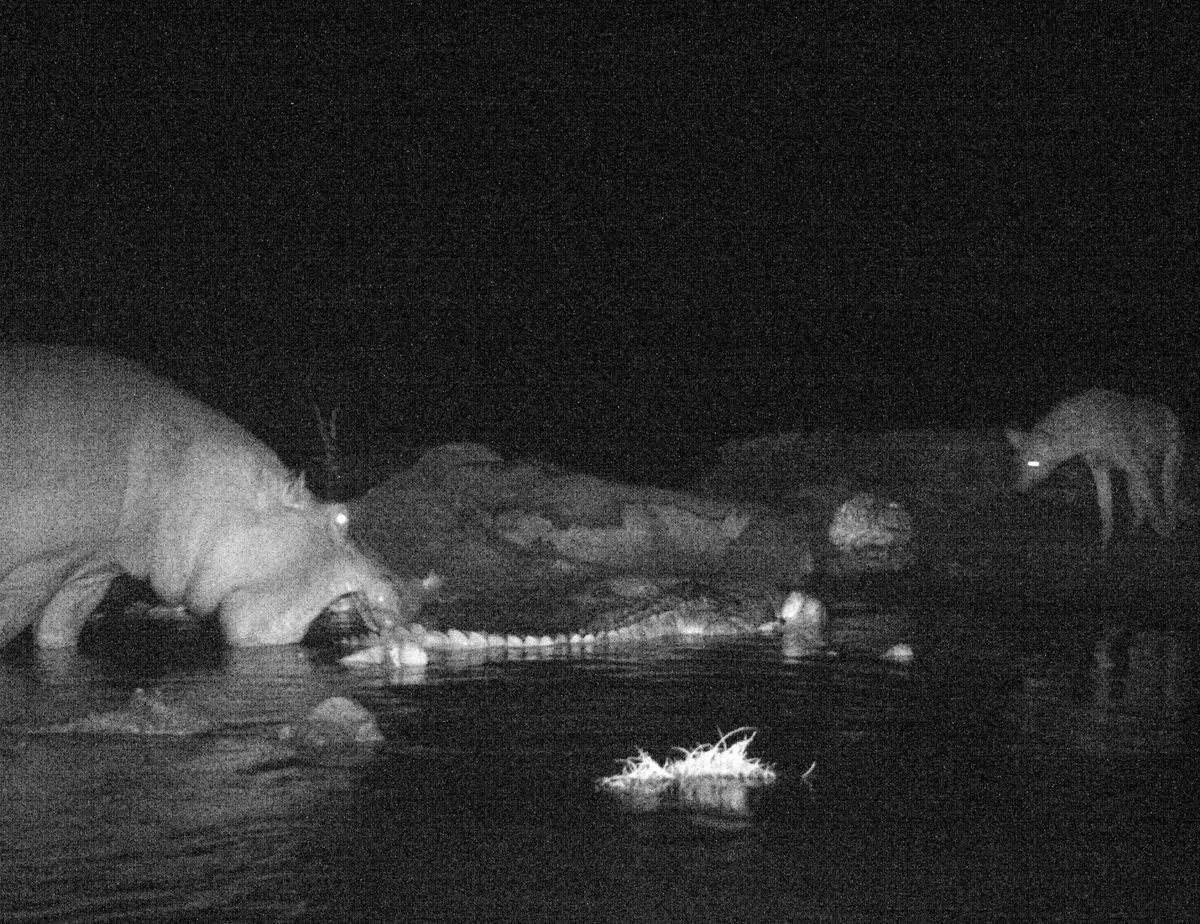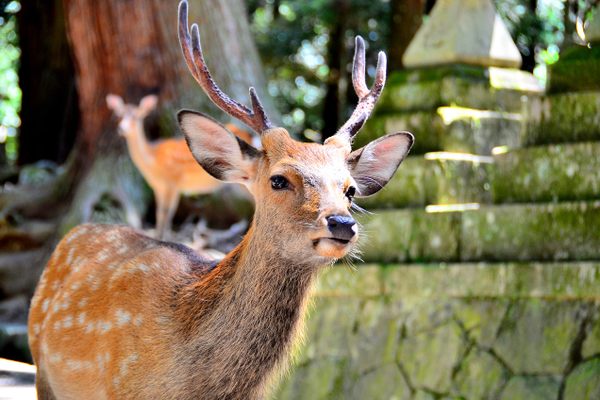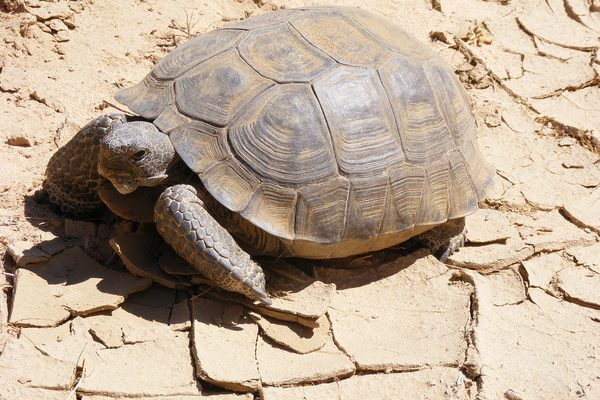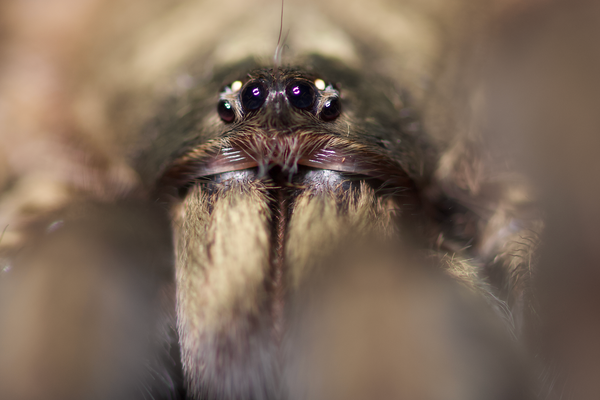You Never Know Who Will Turn Up at an Elephant Carcass
Researchers in Kenya spied some unexpected guests at these “carrion bonanzas”
Hyenas, vultures, lions, leopards. They all seem like expected dinner guests to a feast consisting of a massive elephant carcass. But recently, researchers in Kenya caught an unexpected diner on camera. The elephant in the room, it turned out, was a hippo.
In 2019, an international team of researchers mounted camera traps at two fresh elephant carcasses—what the authors call “carrion bonanzas”—in Tsavo East National Park. In their recent study in the journal Food Webs*, they compare the death of an elephant in the park’s dry landscape to a whale fall (when a dead cetacean sinks to the bottom of the ocean), a feast that can support or even create a whole ecological community. Over a month of recording they saw the usual suspects of predators and scavengers take turns at the carcass throughout the night. Occasionally, there were oddities and surprises: unlikely diners eating side by side, young hyenas with snares on their necks, and that rare hippo—a case of megaherbivore eating another megaherbivore—and more.
“There’s a lot of really interesting things going on at the elephant carcasses,” says coauthor Aaron Morris, a doctoral candidate studying wildlife ecology at the University of Minnesota (UMN). “With all this big charismatic megafauna around, you sometimes don’t stop to look and see.”

This team is doing just that. One carcass was on dry land, while the other sat on the bank of the Galana River, the only water course that will last through the intense sub-Saharan dry season. Elephants might be killed by poachers for their massive tusks, or die as a result of traveling long distances between water and food during drought. In this case, one of the elephants was euthanized by park staff after suffering a broken leg, while the riverside one died of unknown natural causes. Because poaching is such a major threat in the park, the area is well patrolled, so researchers were able to monitor both carcasses soon after death.
While camera traps are becoming a more popular tool for tracking wildlife, it’s rare to have an opportunity to record interactions at such large and long-lasting carcasses. “Many researchers use remote cameras to monitor the fate of mammal carcasses of all sizes,” says coauthor Joseph Bump, an ecologist at UMN. “Very few have focused on elephants, perhaps none at a river’s edge.”
Researchers wanted to examine how various species interact at a single, massive dining table. Camera traps offered the researchers a way to observe the animals continuously and without disturbing them. “It can be mind-bending, getting a peek into their secret lives,” says Stotra Chakrabarti, the corresponding author of the study and a behavioral ecologist at Macalester College in Minnesota. “The things we find with remote cameras are just phenomenal—it’s like watching their lives and interactions unfold in front of your eyes.”
At least once a week, the team trekked into the hot savannah, just two degrees above the equator, to retrieve memory cards from the cameras. On these excursions, they faced herds of elephants and river banks full of crocodiles. Coauthor Stephen Nyaga, a researcher and ranger at the Wildlife Research and Training Institute in Kenya, was vital on these missions. Morris, who has also trekked around polar-bear infested whale carcasses for research in the Arctic, relies heavily on local guides. “Going into the field with [Nyaga] was incredible,” says Morris. “It was super-invaluable because of his knowledge.”
Those evenings, Morris and coauthor Fredrick Lala, a research scientist for the Kenya Wildlife Service and doctoral candidate at UMN, would crack open a cold Stoney Tangawizi—a popular ginger soda—and sit back to watch the show they had collected.
One evening, as they watched the passing images of lions and hyenas and buzzards, a surprise sauntered into focus. A hippo. At first it could have been just nosing around, but then it started to actively bite and pull the flesh up to chew, says Morris. “Whoa, that’s pretty cool,” he remembers saying. Hippo predominately dine on plants, but have been known to opportunistically and occasionally indulge in meat. “It was nice to be able to add to this really kind of a unique set of observations,” he adds.

The hippo wasn’t the only surprise. The expected lions, hyenas, and leopards rarely shared the meal at the same time, despite the ample supply. But near the water’s edge, hyenas and crocodiles feasted together. Researchers aren’t sure why some animals are content to eat side by side. It could be that, for example, crocodiles can’t tear flesh easily, so they let the hyenas open up the carcass and then join in, or it could be that the animals just have such different niches that they tolerate each other. Or maybe the crocodiles and hyenas just can’t get rid of one other at the intersection of water and land. “We don’t know,” Chakrabarti says. “This research presents more interesting questions than answers.
Rob Davis, a postdoctoral researcher at Nelson Mandela University in South Africa, also uses camera traps to study carnivores in East Africa. “I think this study highlights an understudied aspect of food web ecology, the potential for these mega-carcasses to act as resource hotspots that can intensify levels of competition between species,” says Davis, who was not involved in the research. “I think this study, and the wider use of camera traps to monitor carcasses, will be important for expanding our knowledge of interactions at these resource hotspots.”
International conservationist and elephant advocate Paula Kahumbu, CEO of Wildlife Direct in Nairobi, agrees that the paper is interesting, but has questions that camera traps may not be able to answer. “Camera traps give us new insights, but they still only inform us about large animal interactions, and we know that insects and smaller animals may be having an equal or greater role in the food web,” she says. “Much of the nutrients from large mammal carcasses ends up in the soil and in water systems—that impact on micro- and macro-ecology has never really been explored adequately.”

Morris has thought of that big, lasting ecological picture, too. “Thinking about the elephant carcasses as the terrestrial analog for whale falls, a whale fall can create a whole ecosystem in a barren place, and we see that happening with the elephant carcasses,” he says. “This paper deals with things that are kind of immediate, but we also have these indirect impacts from elephant carcasses that have been documented out to five years, and I’m sure that they go well beyond that.”
“In wildlife research, every time we learn something new, it reminds us of how wonderful the natural world is. I’m still blown away by it.” says Chakrabarti. “It inspires wonder and awe in people.” He hopes this awe can lead to action.
“To make conservation happen,” he adds, “everyone needs to throw their weight behind it, and such documentation of the wonders of the natural world are great tools.”
* Correction: The original version of this story named Science Direct as the journal.































Follow us on Twitter to get the latest on the world's hidden wonders.
Like us on Facebook to get the latest on the world's hidden wonders.
Follow us on Twitter Like us on Facebook